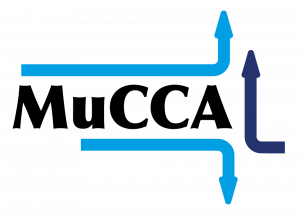About tsc_admin
This author has yet to write their bio.Meanwhile lets just say that we are proud tsc_admin contributed a whooping 8 entries.
Entries by tsc_admin
Vehicle-to-Vehicle communication in MuCCA
27th March, 2020 in Blog /by tsc_adminWatch our webinar here
24th March, 2020 in Milestones, News /by tsc_adminThe Multi Car Collision Avoidance (MuCCA) Research & Development project final showcase webinar took place on the 19th March 2020. The recording includes presentations from the Centre for Connected and Autonomous Vehicles (CCAV) and the MuCCA consortium including, Applus Idiada, Connected Places Catapult, Cosworth Electronics, SBD Automotive, Cranfield University and Westfield Sportscars. The webinar also showcased the first view of the final demonstration video. Finally the webinar finished with a Q&A to the consortium from the audience. If you missed the webinar or would like to review it again please click here.
Connected vehicle project could end motorway pileups
19th March, 2020 in Milestones, News /by tsc_adminA pioneering project has developed technology that could radically reduce the number of multi-vehicle collisions on motorways. The Multi-Car Collision Avoidance (MuCCA) research and development project, has used artificial intelligence (AI) and vehicle-to-vehicle (V2V) communications to instruct autonomous vehicles to cooperatively make decisions to avoid potential incidents. The project, funded by Innovate UK and the Centre for Connected and Autonomous Vehicles (CCAV), and delivered by a consortium led by Applus IDIADA with Cranfield University, Westfield Sports Cars, Cosworth, SBD Automotive and Connected Places Catapult, has seen MuCCA equipped vehicles successfully complete replicas of real-life UK motorway scenarios on test tracks. When the technology in the vehicles detects an incident, the cars share information by radio links, and the on-board computers calculate the best manoeuvres to avoid the obstacles and then safely steer the agreed path to avoid an accident. The MuCCA equipped vehicles also avoid each other and remove the need to brake suddenly – which may have caused vehicles behind to drive into them. Connected and autonomous vehicles (CAVs) are expected to become increasingly common on our roads within the next 10 years, there will however be many non-autonomous ‘human driven’ vehicles that will remain for the foreseeable future. In this near future scenario, MuCCA equipped vehicles could take on the added complexity of anticipating the likely behaviour of any human drivers in the vicinity of an incident. Although the UK has some of the safest roads in the world, around 4,500 accidents still happen on UK motorways each year, contributing to 1,700 annual deaths and over 22,000 serious injuries[1]. Incidents on the motorway network also cause delays and congestions which can have a serious economic impact on UK businesses, costing around £8 billion a year according to estimates. MuCCA technology has the potential to significantly reduce these. Rachel Maclean MP, Minister of Transport, Department of Transport said: “The potential of self-driving vehicle technology is unprecedented and could help to level up transport across the nation by making every day journeys greener, safer, more flexible and more reliable. The MuCCA project is yet further proof of the UK leading the way in the safe and secure development of self-driving vehicle technology.” Charlie Wartnaby, Technical Lead, Applus IDIADA UK said: The MuCCA project has delivered a world first, achieving collective collision avoidance behaviour between real cars, in a clear demonstration of fully automated cooperative control mediated by vehicle-to-vehicle radio. Combining connectivity and automated driving like this has applications beyond the valuable emergency role proven here to more general cooperative vehicle movement, promising enhanced safety […]
Is MuCCA leading the pack for collaborative, collision avoiding technology?
11th April, 2019 in Blog /by tsc_adminBy Stuart Rowell, Principal Technologist, Connected Places Catapult The MuCCA (Multi-Car Collision Avoidance) project has a grand aim; using connectivity and autonomy to avoid (or minimise) damage in high speed, multi-vehicle traffic accidents. Our MuCCA-equipped cars will be able to sense danger, communicate that danger amongst themselves, collectively decide on a best course of action, take control of the vehicle, and then safely hand back to the driver at the appropriate time. Best of all, this technology will recognise all vehicles, not just those MuCCA-equipped, and so supporting the gradual roll-out of connected and autonomous vehicles (CAVs). We are developing this next-generation driver aid through collaboration with world-leading industry partners. We are using advanced artificial intelligence, vehicle-to-vehicle (V2V) communications and sensor fusion to take a significant evolutionary step in automated vehicle development. But we’re not alone in looking into advanced driver aid connectivity and autonomy. With Toyota announcing their ‘Guardian’ system at CES 2019, let’s consider where MuCCA sits in the global race to deploy safe, reliable CAVs onto public roads. What makes MuCCA different? Tesla’s Autopilot system and notable German manufacturers (Mercedes’ Driving Assistance Plus, Audi’s Traffic Jam Pilot) are carrying out some exciting work when it comes to developing advanced driver assistance systems (ADAS). Other manufacturers (for example Nissan and Jaguar Land Rover) are developing similar technologies – looking at anticipation, collision-avoidance control and vehicle-to-vehicle communication. But we believe MuCCA is the only collaborative project with the ambition of bringing all of these elements together into one system. So what specific capabilities will MuCCA be developing? Anticipation of the trajectories of other vehicles ahead, alongside and behind the primary vehicle Communication with other MuCCA-equipped vehicles to communicate possible collision hazards and to receive information from other vehicles further ahead Planning of a coordinated swarm-like response for all vehicles to best avoid the hazard Execution of the necessary emergency collision-avoidance control decisions (braking, acceleration and steering) MuCCA is addressing the immediate, close proximity emergency – it will not rely on previous highway or sat nav information to be alerted to potential hazards but will be responding to real-world, high-speed incidents on our fastest roads. And once the best course of action is decided by the MuCCA system, it will brake, accelerate and steer the vehicle to protect the passengers and other road users. Evasive steering systems When it comes to the […]
Understanding human driver behaviour
9th November, 2018 in Blog /by tsc_adminBy Ross Walker, Research Fellow in Autonomous Cars, Cranfield University The Multi-Car Collision Avoidance (MuCCA) Project will develop a next-generation driver aid that aims to avoid multi-car collisions on motorways – if an accident cannot be avoided, the MuCCA system will attempt to minimise its consequences (both injuries and damage). But before the MuCCA vehicles are able to react to these potentially dangerous situations, they have to understand how a human driver would react. And to do so, we need to develop a training algorithm that predicts how drivers behave when avoiding collisions. Accident prevention Drivers avoid accidents by reacting fast enough to a dangerous situation, however for multiple car collisions simply reacting may not be enough. By modelling how human drivers behave on motorways, and how the proximity of surrounding cars influence their behaviour, the movement of the cars that surround the MuCCA vehicle can be predicted over the next few seconds. This can allow any potential accidents to be recognised in advance, and consequently avoided before they have chance to begin developing. Data acquisition To predict potential accidents we first need to learn the driver trajectories that result in them. To safely obtain such trajectory data we use simulation software so that accidents can be created within a virtual (safe) environment. Tailoring scenarios to the MuCCA Project The MuCCA project deals with up to five vehicles moving along a passage of UK motorway; the prediction algorithm adopts the same parameters, and various training scenarios are devised so that meaningful human driving behaviour can be captured in the simulator. To begin, a simple test should always be carried out when initially developing an algorithm – this is to ensure results are as expected and the algorithm is behaving correctly. A simple behaviour was captured from a single vehicle having to pass by a broken down car in their lane. This was primarily to gauge if the driver’s reaction time to the blocked lane replicated a real-life scenario. The introduction of multiple cars allowed us to capture data on how well the drivers maintained motorway lane discipline. It also gave insight into how drivers undertake, lane-hog, or tailgate, which all increase the likelihood of a collision. a) Which lane will the leading HDV move to? b) How will the back HDV cope with the front HDV moving in front? c) What will the right HDV […]
Using a Systems Engineering approach
14th September, 2018 in Blog /by tsc_adminMulti-Car Collision Avoidance Project (MuCCA) is a complex, collaborative R&D project that can benefit greatly from a systems engineering approach, says Thomas Levermore, a Systems Engineer at the Transport Systems Catapult (TSC). The MuCCA project will develop a next-generation driver aid that aims to avoid multi-car collisions on motorways – if an accident cannot be avoided, the MuCCA system will attempt to minimise its consequences (both injuries and damage). This is a complex project by any definition, and by applying systems engineering methods, we can introduce technological innovation into the planning and development stages. The starting point of the systems engineering process is pulling together the requirements of the stakeholders. The MuCCA project brings together six partners, each contributing to the common goal of reducing the number and severity of multi-car collisions. However, with partners coming from academia, small, medium and large companies, each has a different approach and existing technical systems to incorporate. Before all the partners begin to develop their parts of the MuCCA system, systems engineering ensures everyone takes a step back, looks at the system as a whole in order to understand its purpose and where their elements of the system fit with others. As a systems engineering team at TSC we provide neutral guidance to the system design to balance each partners’ objectives and ensure the system meets the needs of future users. By developing an operational concept for the system, all the assumptions and constraints can be documented and a definition of what the system will (and importantly won’t) do can be agreed upon. Fostering agreement To reach an agreement on the scope of the MuCCA prototype system, use cases were developed along with the operational concept to describe situations in which the system is to intervene. These use cases were described by the approximate relative starting positions and speeds of the cars involved. Examples are two side-by-side cars avoiding a crashed vehicle, and a car avoiding a crash ahead which is partially obscured by the car in front. > From this foundation, requirements were discussed with the consortium to detail what the system is required to do so that it can achieve the objectives of the project. > With an operational concept and an initial set of requirements, the v-model process followed in this project leads to development of the system architecture. Figure 1: V-model Systems Engineering process Defining an architecture A cornerstone of any successful systems engineering process is a well-defined system architecture. At the mention of system architecture, it is common to imagine a diagram of how physical pieces of equipment fit together. Often when existing components are available to be used in a system, there is a tendency to work backwards from what is available to dictate what the functionality of the system can be, resulting in a limited system. Going straight to the physical architecture misses a vital step in the process. Taking a step back and looking at the functionality needed to satisfy the requirements allows a functional architecture to be developed […]
Decision making algorithms
21st August, 2018 in Blog /by tsc_adminMuCCA cooperative path-planning/decision making algorithms and its applications on motorways Are we ready for autonomous driving? How autonomous driving can assist humans on the motorways? These issues are recurrent nowadays in the face of the biggest challenges that are appearing to building safety systems on our roads. Autonomous driving systems can help decrease fatalities caused by traffic accidents. However, this technology has a good deal of aspects to be improved so as planning obstacle-free paths for a vehicle to increase highway safety. A challenging research task for autonomous driving is the coordination of several autonomous cars. This new technology is the guarantee of making car traffic safer in the future. Cooperative systems have just recently started to be explored in the context of automated driving and are expected to become increasingly common on motorways. In this context, the MuCCA (Multi-Car Collision Avoidance) project, funded by the Centre for Connected and Autonomous Vehicles (CCAV) via Innovate UK, is developing a cooperative system that will enable connected and autonomous vehicles (CAVs) to avoid collisions. As part of this project, Cranfield University is responsible for developing robust algorithms for path prediction and decision-making/inter-vehicle communication. The actual version of the algorithms developed considered a strategy based on model predictive control (MPC) to make cooperative decisions to avoid a potential accident. We explored an extending cooperative path-planning approach to traffic where human drivers are present in on-road scenarios. In the not-too-distant future, it is feasible that cooperative solutions to driving manoeuvres that would enable autonomous vehicles to simultaneously coexist on the roads with vehicles driven by humans. In this context, the human driver model (HDM) needs to be integrated with the autonomous planning in order to safely interact with the autonomous vehicles on the road. Our cooperative planning framework re-plans the route of the vehicle for each step and can be summarized in Figure 1. This solution is able to provide the following improvements and capabilities: Incorporation of constraints for smoother manoeuvring when avoiding obstacle. System constraints are the set of rules to drive on roads, road boundaries and logical propositions that guarantee a safe distance to other MuCCA vehicles and obstacles. Increased prediction horizon for path planning and more short horizon for trajectory control in order to get better predictions and precise vehicle control. Demonstrates V2V communications to avoid collisions. The plans of other vehicles can be communicated in real […]
Our Partners
NEWS AND SOCIAL
- MuCCA and the Regulatory Environment28th March, 2020
- Vehicle-to-Vehicle communication in MuCCA27th March, 2020
- Watch our webinar here24th March, 2020
The Multi Car Collision Avoidance (MuCCA) Research & Development project final showcase webinar took place on the 19th March 2020. The recording includes presentations from the Centre for Connected and Autonomous Vehicles (CCAV) and the MuCCA consortium including, Applus Idiada, Connected Places Catapult, Cosworth Electronics, SBD Automotive, Cranfield University and Westfield Sportscars. The webinar also showcased the first view of the final demonstration video. Finally the webinar finished with a Q&A to the consortium from the audience. If you missed the webinar or would like to review it again please click here.







